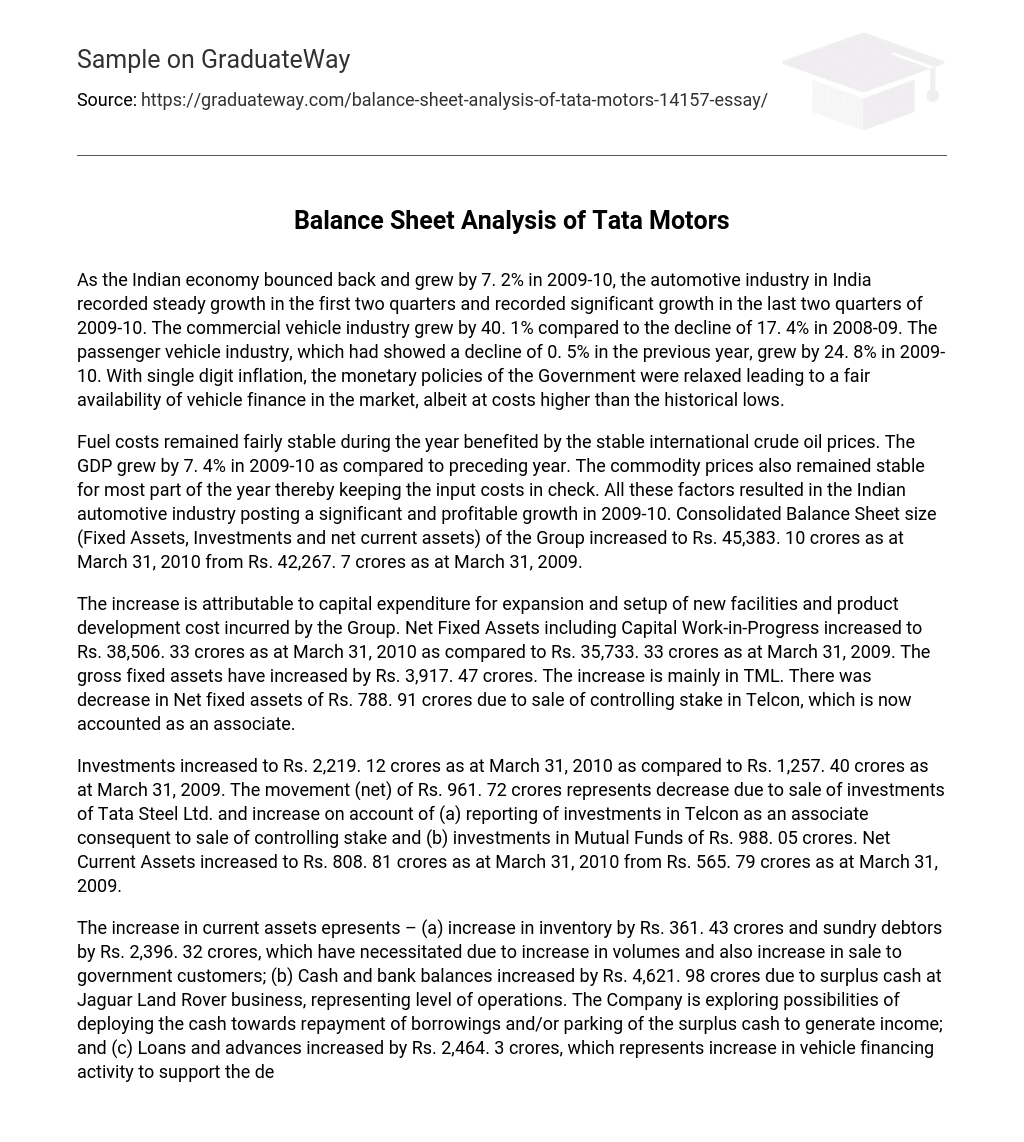As the Indian economy bounced back and grew by 7. 2% in 2009-10, the automotive industry in India recorded steady growth in the first two quarters and recorded significant growth in the last two quarters of 2009-10. The commercial vehicle industry grew by 40. 1% compared to the decline of 17. 4% in 2008-09. The passenger vehicle industry, which had showed a decline of 0. 5% in the previous year, grew by 24. 8% in 2009-10. With single digit inflation, the monetary policies of the Government were relaxed leading to a fair availability of vehicle finance in the market, albeit at costs higher than the historical lows.
Fuel costs remained fairly stable during the year benefited by the stable international crude oil prices. The GDP grew by 7. 4% in 2009-10 as compared to preceding year. The commodity prices also remained stable for most part of the year thereby keeping the input costs in check. All these factors resulted in the Indian automotive industry posting a significant and profitable growth in 2009-10. Consolidated Balance Sheet size (Fixed Assets, Investments and net current assets) of the Group increased to Rs. 45,383. 10 crores as at March 31, 2010 from Rs. 42,267. 7 crores as at March 31, 2009.
The increase is attributable to capital expenditure for expansion and setup of new facilities and product development cost incurred by the Group. Net Fixed Assets including Capital Work-in-Progress increased to Rs. 38,506. 33 crores as at March 31, 2010 as compared to Rs. 35,733. 33 crores as at March 31, 2009. The gross fixed assets have increased by Rs. 3,917. 47 crores. The increase is mainly in TML. There was decrease in Net fixed assets of Rs. 788. 91 crores due to sale of controlling stake in Telcon, which is now accounted as an associate.
Investments increased to Rs. 2,219. 12 crores as at March 31, 2010 as compared to Rs. 1,257. 40 crores as at March 31, 2009. The movement (net) of Rs. 961. 72 crores represents decrease due to sale of investments of Tata Steel Ltd. and increase on account of (a) reporting of investments in Telcon as an associate consequent to sale of controlling stake and (b) investments in Mutual Funds of Rs. 988. 05 crores. Net Current Assets increased to Rs. 808. 81 crores as at March 31, 2010 from Rs. 565. 79 crores as at March 31, 2009.
The increase in current assets epresents – (a) increase in inventory by Rs. 361. 43 crores and sundry debtors by Rs. 2,396. 32 crores, which have necessitated due to increase in volumes and also increase in sale to government customers; (b) Cash and bank balances increased by Rs. 4,621. 98 crores due to surplus cash at Jaguar Land Rover business, representing level of operations. The Company is exploring possibilities of deploying the cash towards repayment of borrowings and/or parking of the surplus cash to generate income; and (c) Loans and advances increased by Rs. 2,464. 3 crores, which represents increase in vehicle financing activity to support the demand; net increase in receivable on account of Minimum Alternative Tax credit entitlement in future years and increase in excise duty/VAT and other dues from the government. Current liabilities have increased on account of increase in sundry creditors and acceptances and liability towards premium on redemption of Non-Convertible Debentures created during 2009-10 of Rs. 1,745. 79 crores. The increase in creditors/acceptances relate to volumes in the current year, more particularly in the last quarter.
Provisions have decreased due to decrease in Provision for warranty and residual risk at Jaguar Land Rover business. Gross debt (total of secured and unsecured loans) increased marginally to Rs. 35,192. 36 crores as at March 31, 2010 as compared to Rs. 34,973. 85 crores as at March 31, 2009. Bridge Loan taken for Jaguar and Land Rover business was paid during 2009-10, through funds raised, improved cash generation from operations and sale of certain investments. Net debt (gross debt reduced by available cash and bank balances and mutual fund investments) stood at Rs. 27,170. 49 crores as at March 31, 2010 as compared to Rs. 2,505. 52 crores as at March 31, 2009. The reduction represents surplus cash and bank balances and increase in mutual fund investments. The cash generated from operations before working capital changes and before considering deployment in the vehicle financing business was Rs. 7,955. 29 crores as compared to Rs. 2,776. 58 crores in the previous year. After considering the impact of working capital changes and inflows on account of securitization of financing loan portfolio (net of deployment), the net cash generated from operations was at Rs. 9,326. 93 crores as compared to Rs. 749. 83 crores in the previous year.
The cash increase on account of change in operating assets and liabilities of Rs. 2,600. 85 crores in 2009-10 was due to increase in trade and other payables by Rs. 8,079. 11 crores due to increase in manufacturing activity which was partially offset by (a) Increase in trade and other receivables amounting Rs. 4,342. 63 crores due to increase in sales volumes; (b) Increase in inventories amounting to Rs. 1,244. 53 crores on account of increase in manufacturing activity and due to higher sales volume; and (c) Increase in vehicle/loans and hire purchase receivables by Rs. 521. 10 crores.





